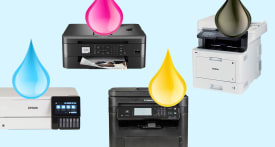How to Save If Tariffs Cause Price Hikes on Tech Products and Appliances
Prices could rise the most on phones, laptops, TVs, and certain home appliances

In some ways, Greg Capra considers himself lucky. A videographer and musician based in Westchester County, N.Y., he bought a much-needed Mac Mini computer just before the proposed new tariffs on imported goods took effect. But, like many of us, he’s now debating the purchase he had hoped to make next: a portable battery system in case the power goes out in a storm.
“With everything that’s going on, I had to decide if this is something our family really needs,” he says.
What Are Tariffs?
Tariffs are fees levied on goods and materials imported from other countries. They’re paid by the U.S. companies doing the importing, and those costs often get passed on to consumers.
The new tariffs were introduced in waves and have shifted significantly as countries and manufacturing companies negotiate with President Donald Trump’s administration. In early April, the U.S. implemented a 10 percent fee on all goods brought into this country. More aggressive “reciprocal” tariffs were then levied against 60-plus countries, with China receiving penalties that exceeded 100 percent. The administration opened the door for products like smartphones, computers, and memory chips to receive exemptions from the higher tariffs on China but has since clarified that they are simply being moved to a different tariff designation. For now, things are still very fluid.
“Smartphones, TVs, and laptops will be among the products most affected,” Sunderesh Heragu, a professor and senior adviser to the dean of the College of Engineering, Architecture and Technology at Oklahoma State University, told CR when the tariffs were first announced. If President Trump imposes tariffs on semiconductor chips, as he has indicated, Heragu says that "prices of all appliances and devices that have a chip in them, including washers, dryers, kitchen and home gadgets, watches, and others, would increase.”
In addition to the new tariffs on Chinese imports, President Trump closed a little-known customs exemption that allowed online retailers such as Temu and Shein to bring low-cost goods from China into the U.S. duty-free. The order, which takes effect May 2, affects goods worth less than $800.
How Much More Will Products Cost?
Based on earlier announcements of both universal and reciprocal tariffs, Ralph McLaughlin, chief economist for market intelligence data firm OpenBrand, estimated prices on electronics and appliances could rise 30 to 40 percent over the next 10 months. For laptops and smartphones, it might be more like 40 to 50 percent, according to Shawn DuBravac, chief economist at IPC, a global electronics association. That can all change, however, depending on what tariffs are ultimately levied on a number of countries, particularly China.
Analysts at OpenBrand have already seen small price increases in some products they track. Chief economist McLaughlin says the company’s March consumer price index showed the largest increases in appliances such as washers and dryers, dishwashers, and microwaves. For certain laptops, the increases have been in the 5 to 10 percent range.
Other product analysts have seen small upticks in pricing for items such as refrigerators and ranges, though the pricing for floor care products such as vacuums has been stable so far.
When Will Higher Prices Arrive?
Prices probably won’t jump drastically right away, some analysts say. The full effect of the tariffs could take anywhere from a few weeks to several months to surface. But some experts, including Oklahoma State’s Heragu, say we would notice a change sooner.
“The uncertainty surrounding tariffs may cause some manufacturers and retailers to hold off and eat some of those costs in the short run,” McLaughlin says. “I’d expect to see prices first increase in more nuanced ways, such as fewer or lower discounts. If the tariffs seem more permanent, you’ll see manufacturers start to raise suggested retail prices.”
If the tariffs remain in place, he says, some of the impact might be offset by tax breaks, such as write-offs on the interest for car loans and other big-ticket items that consumers buy on credit.
DuBravac says that the speed with which price hikes arrive may also depend on how much inventory retailers have in stock, and how quickly it’s depleted.
What Should You Do Now?
If the tariffs do persist, there are still ways to save money on electronics and appliances. Here are things to keep in mind as you shop:
Don’t wait to buy items you already planned to purchase. If you were gearing up to buy a new appliance, doing it now makes sense, especially if you have money budgeted for it. Big ticket items have larger margins than inexpensive products, so U.S. companies may be more inclined to absorb the extra costs on those in the short term.
Choose reliable products. Higher prices could persist, so it’s particularly important to choose products that are likely to work well over the long term. CR members can use our ratings to review the most and least reliable brands in many product categories, including central air conditioning systems, dishwashers, dryers, heat pumps, refrigerators, vacuums, and washing machines.
Don’t panic-shop. It’s easy to get caught up in the fear of rising prices, but don’t lose your cool and buy things you otherwise wouldn’t.
Hold off a bit on discretionary purchases. At least until we get a better handle on the impact of the tariffs, it makes sense to wait. Who knows? You may find that you don’t really need that item after all. And the government may enact tax breaks and other policies to counter the effects of tariffs on U.S. consumers. Either way, there’s a good chance that you’ll find good deals during promotional events such as Amazon Prime Days and Black Friday, especially if consumers put the brakes on buying earlier in the year.
Shop for older models. TVs, laptops, and smartphones that are a year or two old often remain available at stores after newer models arrive. You can currently buy a 2022 MacBook Air with an M2 processor for as little as $750, for example. It performs almost as well as the new M4 version of the laptop.
Consider a used or refurbished product. While this advice doesn’t work equally well for all product categories, you might find that purchasing a factory-refreshed or gently used appliance, laptop, or phone can save you money. Apple, Best Buy, LG, Samsung, and others certify the products they resell and even offer new warranties. Items sold on eBay typically do not.
Switch to a less expensive brand or model. If prices rise and remain high, you may find that an item with less cachet and fewer bells and whistles suits your needs just fine. Samsung sells a number of well-made Galaxy phones beyond its flagship line, for example. They’re much less expensive but still do virtually everything you want a modern smartphone to do. Consult our ratings for help finding products with a nice balance of price and performance.
Look for U.S.-made options. For many electronics and appliance products, this will be difficult, but you can find headphones and speakers manufactured in this country, for example. OpenBrand economist McLaughlin also suggests looking into alternative options made in countries other than China.




















